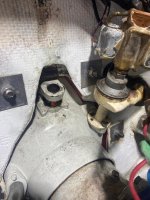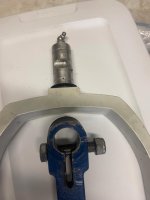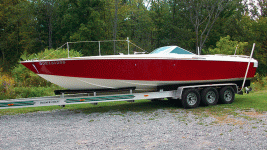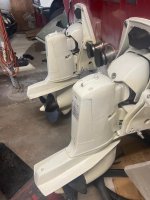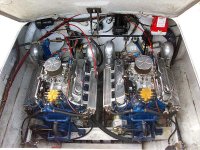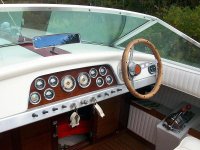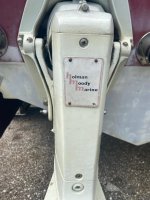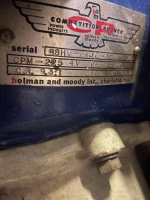Hello, new member, but have been reading for a while.
1968 Bertram Baron twin holman-moody 289 volvo aq250 (I *THINK* it is a 250 based on pictures and PZ NR 250 1748 B)
Engines and drives spotless, almost showroom (same for boat)
(had helmet off in about 1 minute) Nothing on this boat is seized/rusted/stuck, even steering fork is free moving.
Outdrive swings freely port/starboard and has no play on the vertical access.
Problem...While keeping the out-drive stationary, the steering arm (tiller?) inside can move 6"
I can see the yoke shaft not moving, but the steering arm is moving through 6" of travel so seemingly not connected (well) to splines on steering yoke shaft.
This behavior is odd, because once the free movement stops, the tiller does indeed start to move the drive
I can force it against the person holding the drive outside the boat.
Move it 6" the other way freely and again, it has purchase on the drive and the person outside can feel me trying to move the drive.
Loosened the pinch nut generously, drove steel chisel into the gap on tiller arm.
Drove wood wedges into gap above yoke and under transom shield to the point I thought i would bend or break yoke (learned all this from the forum, thanks RicardoMarine and the other contributors).
Used impact socket (smaller than yoke shaft) and hammer to 'persuade' it a bit from inside.
Absolutely no movement and the sound I hear is very metallic, as if the shaft is being held in place by a collar or some other immovable metal barrier. (reminder: tiller arm moves freely back and forth on yoke shaft 6" inches of play)
I've not removed the drive, just the helmet assembly.
Have been dreaming some theory that I need to remove the drive, pivot the fork to a full 90 degrees and it will fall out in my hands ; )
#1 did i guess the model number correctly? I found a page of diagrams some having PZ NR ranges that seemed to indicate this is a 250.
#2 is there such a thing as some kind of step I haven't yet accomplished and I'm working AGAINST that barrier?
#3 if I had to heat something, would have no idea what it could be, tiller arm moves freely on yoke shaft (when it should not due to splines)
#4 do I just redouble my efforts: a little move force on the outside wedges and little more aggressive pounding from inside?
Sincerely appreciate in advance any guidance.
Best Regards,
Rich
PS. Edited this post to remove (or attempt to remove) a bunch of HTML looking stuff that got embedded in the text. Not sure I succeeded.
1968 Bertram Baron twin holman-moody 289 volvo aq250 (I *THINK* it is a 250 based on pictures and PZ NR 250 1748 B)
Engines and drives spotless, almost showroom (same for boat)
(had helmet off in about 1 minute) Nothing on this boat is seized/rusted/stuck, even steering fork is free moving.
Outdrive swings freely port/starboard and has no play on the vertical access.
Problem...While keeping the out-drive stationary, the steering arm (tiller?) inside can move 6"
I can see the yoke shaft not moving, but the steering arm is moving through 6" of travel so seemingly not connected (well) to splines on steering yoke shaft.
This behavior is odd, because once the free movement stops, the tiller does indeed start to move the drive
I can force it against the person holding the drive outside the boat.
Move it 6" the other way freely and again, it has purchase on the drive and the person outside can feel me trying to move the drive.
Loosened the pinch nut generously, drove steel chisel into the gap on tiller arm.
Drove wood wedges into gap above yoke and under transom shield to the point I thought i would bend or break yoke (learned all this from the forum, thanks RicardoMarine and the other contributors).
Used impact socket (smaller than yoke shaft) and hammer to 'persuade' it a bit from inside.
Absolutely no movement and the sound I hear is very metallic, as if the shaft is being held in place by a collar or some other immovable metal barrier. (reminder: tiller arm moves freely back and forth on yoke shaft 6" inches of play)
I've not removed the drive, just the helmet assembly.
Have been dreaming some theory that I need to remove the drive, pivot the fork to a full 90 degrees and it will fall out in my hands ; )
#1 did i guess the model number correctly? I found a page of diagrams some having PZ NR ranges that seemed to indicate this is a 250.
#2 is there such a thing as some kind of step I haven't yet accomplished and I'm working AGAINST that barrier?
#3 if I had to heat something, would have no idea what it could be, tiller arm moves freely on yoke shaft (when it should not due to splines)
#4 do I just redouble my efforts: a little move force on the outside wedges and little more aggressive pounding from inside?
Sincerely appreciate in advance any guidance.
Best Regards,
Rich
PS. Edited this post to remove (or attempt to remove) a bunch of HTML looking stuff that got embedded in the text. Not sure I succeeded.
Last edited:


